Your Cart is Empty
Menu

Best Ebike Conversion Kits: The Ultimate Guide
May 07, 2024

Starting your eco-friendly journey doesn't have to mean buying a brand-new electric bike. For cycling enthusiasts and casual riders alike, e-bike conversion kits offer a smart, affordable alternative to purchasing a new e-bike. These kits transform your trusty bicycle into a pedal-assist powerhouse, helping you conquer hills, tackle longer commutes, and rediscover the joy of riding without breaking the bank.
Key Takeaways:
- Converting your existing bicycle with an e-bike conversion kit offers a cost-effective and environmentally friendly way to enhance your cycling experience.
- The best kit for you depends heavily on individual needs, riding style, desired power, and your comfort level with the installation process.
- Top e-bike conversion kit contenders often include BAFANG for powerful mid-drive options, Swytch for its universal, lightweight design, and Cytronex for its smooth, on-demand power boost.
- Always prioritize safety by wearing a helmet, familiarizing yourself with e-bike laws in your area, and starting with gradual power assist.
Conversion kits are a cost-effective alternative to brand-new e-bikes and a great way to give your existing bike a new lease on life. This article explains everything you need to know before buying one.
Understanding E-Bike Conversion Kits
E-bike conversion kits are truly a game-changer when it comes to cycling. Think of them as a power upgrade for your existing bicycle. These kits contain all the necessary components to transform your regular bike into an electric-assist machine. Essentially, you're adding a motor, a battery, and a few extra bits to give your rides a welcome boost.

Let's break down the basics:
Types of Kits
There are three main categories of e-bike conversion kits. Each offers different advantages and works in slightly different ways:
- Front-wheel kits:The front wheel of your bike is replaced with a wheel that has a built-in electric motor (within the hub). When activated, the motor spins the front wheel, essentially pulling you along. This is often the most affordable and easiest to install but it can affect steering and handling slightly. This might not be ideal for very hilly terrain.
- Rear-wheel kits:Similar to the front-wheel kit, the motor is integrated into the rear wheel. This kit propels you from behind. It provides a more natural "pushing" sensation, better for tackling hills, but the installation can be a bit more complex than that of front-wheel kits.
- Mid-drive kits:This type replaces your bike's bottom bracket (where the pedals and cranks connect) with a unit containing the motor. The motor directly assists your pedaling, working through your bike's existing gears. This kit offers the most seamless integration and natural riding feel, excellent for hilly areas. However, this is the most expensive and often the most complex to install.
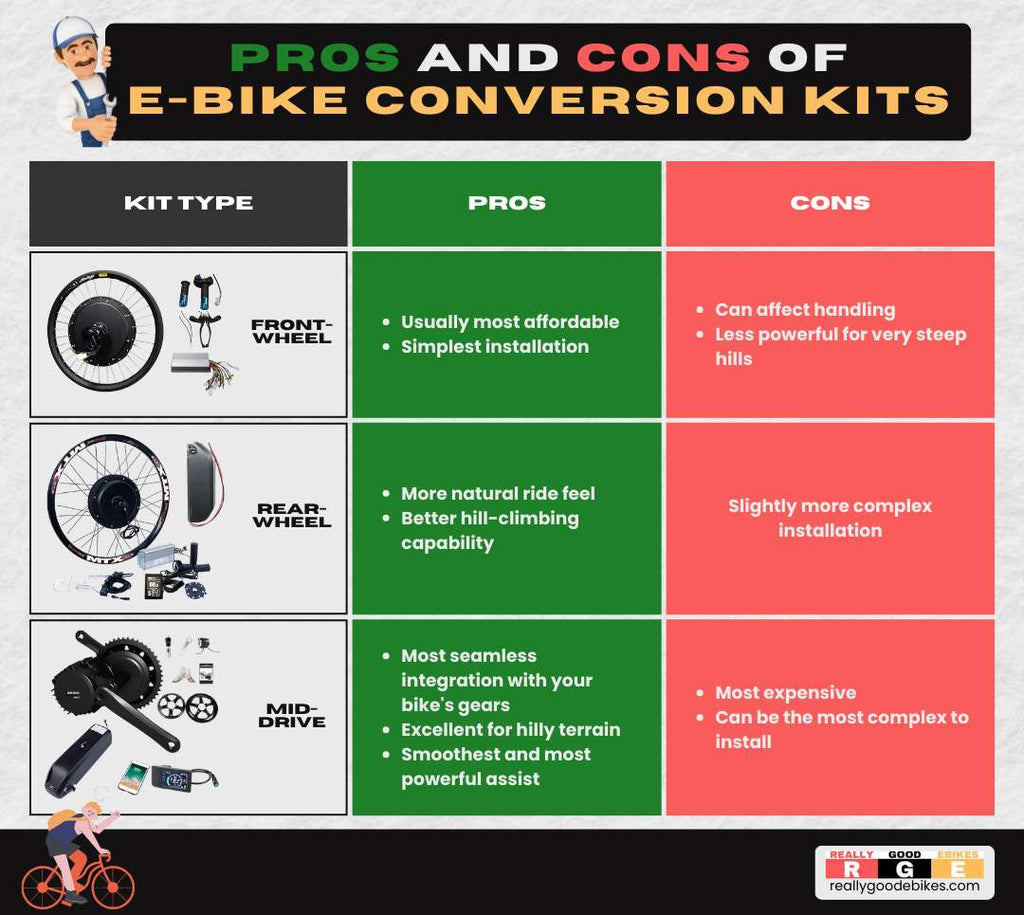
Components
The heart of an e-bike conversion kit lies in its core components, working together to transform your regular bike into an electric-assist machine. Understanding these components will help you compare kits, make informed decisions about power and range, and ultimately get the most out of your e-bike experience.
Motor
The powerhouse of your e-bike, the motor provides the extra boost that makes cycling easier and potentially faster. Motor power is measured in watts (W), with typical options ranging from 250W for basic assistance to 1000W or more for serious hill-climbing and higher speeds. Torque, measured in Newton-meters (Nm), is another critical factor, helping you accelerate from a standstill and conquer those tough inclines.
Battery
The fuel for your motor, the battery in an e-bike conversion kit, is key to determining how far you can ride on a single charge. Battery capacity is measured in amp-hours (Ah) or watt-hours (Wh), with higher numbers translating to a longer range. However, range can vary widely depending on the power of your motor, the terrain you're riding on, your own weight, and the level of pedal assist you choose.
Controller
Think of the controller as the brains of your e-bike system. It works behind the scenes, controlling the flow of power between your battery and the motor and responding to your input from either the throttle or pedal-assist sensors.
Display
The display is your dashboard, giving you real-time information about your ride. Depending on the kit, it might show your speed, battery level, the current pedal-assist mode, and sometimes even additional data like distance traveled or estimated range.
Throttle/Pedal Assist
This determines how you interact with your e-bike's power. A throttle system lets you engage the motor using a twist grip or thumb lever, perfect for those moments when you need a quick boost or want to take a break from pedaling. Pedal assist systems (PAS) sense your pedaling effort and respond automatically, making your natural pedal strokes feel amplified and easier. Many e-bike conversion kits offer both options, letting you choose how you want to ride.
Compatibility
Not every bike is suitable for an e-bike conversion kit. When planning a conversion, you need to consider several key compatibility factors.
The type of bike matters:Most standard bikes can be converted, but mountain bikes, hybrids, and cruisers are especially good choices due to their sturdy frames designed for various terrains. However, road bikes with ultra-light frames are generally only suitable for smooth roads. Additionally, full-suspension mountain bikes are often difficult to convert because of their complex rear suspension systems.
Wheel size is crucial: Conversion kits typically accommodate common sizes like 26-inch, 27.5-inch, 28-inch, and 700c wheels. Kits for less common sizes may be harder to find.
The bike's frame is important: Steel and aluminum frames are preferred for their durability and strength. Carbon fiber frames are usually not recommended because they may not withstand the stress from a motor. It's important to check the dropouts (where the wheels attach), as stronger, thicker dropouts are better able to handle the motor's power.
Consider the brakes:Disc brakes, whether hydraulic or mechanical, are recommended for the additional stopping power required for an e-bike. If your bike has rim brakes, they may suffice, but consider upgrading the brake pads for better performance.
5 Best Ebike Conversion Kits of 2024
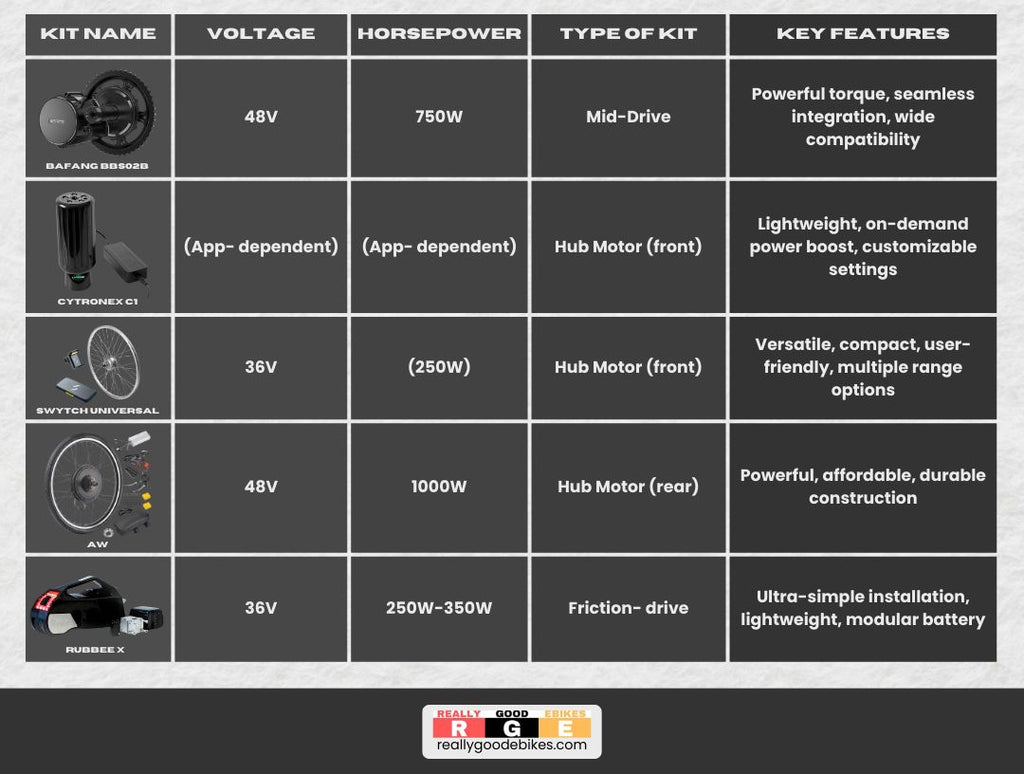
Choosing the right e-bike conversion kit is a big decision. To help you make the best choice, here are some of the top-rated kits on the market, considering factors like power, ease of installation, reliability, and value for money.
1. BAFANG Mid-Drive Ebike Conversion Kits
BAFANG is a major player in the e-bike world, renowned for its robust and customizable conversion kits. They offer both mid-drive and hub motor options to suit different needs and preferences.
BAFANG kits stand out for their power, versatility, and compatibility. Their mid-drive systems, particularly the BBS02B and BBSHD, are popular choices for serious e-bikers who demand hill-climbing power and seamless integration with their bike's gears. Those seeking a smoother, more affordable entry point often find a great fit with BAFANG's reliable hub motor kits.
Crucially, BAFANG kits boast wide compatibility. The BBS02B mid-drive kit specifically accommodates mountain bikes, road bikes, and many other frame styles, fitting a standard 68-73mm bottom bracket (with options for 100mm bottom brackets). The powerful motors, available in 750W and 1000W options with impressive torque, can propel riders up steep inclines and reach speeds exceeding 25 mph.
Installation, while potentially more complex for mid-drive systems, is aided by comprehensive instructions and helpful video guides. Riders enjoy the flexibility of three riding modes: pure electric, pedal-assist, and even traditional bicycle mode for those times when you want a pure workout. BAFANG also shines with its customer support, including service centers in the US, UK, CA, and the EU.
Pros:
- Wide range of power options
- Excellent torque (especially with mid-drive kits)
- Kits are often compatible with many different bike styles
- Good aftermarket support and parts availability
- Multiple riding modes for added versatility
- Responsive customer support
Cons:
- Mid-drive kits can be more complex to install
- Some BAFANG kits may require additional tools or knowledge for setup
- May need to purchase additional components (like displays) separately
2. Cytronex C1 Ebike Conversion Kit
Cytronex delivers a unique and lightweight e-bike conversion solution with its Cytronex C1 Kit. A core philosophy behind this kit is preserving the natural feel of your traditional bike. When the system is off, Cytronex claims the ride experience is completely unchanged, allowing you to use your own pedal power on easy terrain.
However, when tackling hills or facing challenging conditions, the Cytronex C1 promises to provide a smooth, silent power boost at the touch of a button.
The Cytronex system stands out with its intuitive "Boost Button." A single press activates the e-assist motor, and holding the button allows you to cycle through different power levels—all customizable via the companion C1 App. This offers excellent control over the level of assistance you get to match the terrain and your own energy level. Additionally, the Boost Button can activate an optional high-powered LED light system for enhanced visibility.
Pros
- Lightweight design minimizes impact on the bicycle's original feel
- Highly customizable power levels
- Seamless on/off operation for a natural cycling experience.
- Versatile button control with optional lighting integration.
Cons
- May require some technical understanding for setup.
- Pricing might be higher than some competitors.
- App-based adjustments might not be for everyone.
3. Swytch Universal Ebike Conversion Kit
Swytch aims to bring e-biking to the masses with its universal conversion kit that promises to transform your beloved bicycle into an electric machine for a significantly lower cost than buying a new e-bike. One of Swytch's greatest strengths is its focus on simplicity and compatibility. Their kits boast an easy installation process and are designed to work on virtually any bike type, regardless of wheel size or brake style (rim or disc brakes).
Swytch sets itself apart with its remarkably compact and lightweight design. Both the motor and battery pack are surprisingly small, ensuring your converted bike retains a sleek, traditional aesthetic. The kits are designed to comply with road-legal speed limits and offer two range options (15km and 30km) to cater to different commute lengths and riding styles.
Features like the 250W geared hub motor ensure a smooth ride, whether you're using the power assist or relying entirely on your own pedal power. The sine-wave control system further enhances ride quality, delivering a quiet and seamless power delivery experience.
Pros
- Extremely versatile with wide compatibility
- Compact and lightweight design
- Straightforward installation
- Multiple range options for flexibility
- Smooth and quiet motor system
Cons
- Range might be limited for longer commutes/trips
- Some technical knowledge may still be helpful for installation
4. AW Ebike Conversion Kit
The AW Ebike Conversion Kit offers a powerful and budget-friendly option for transforming your regular bicycle into an electric powerhouse. With its 48V 1000W brushless hub motor, this kit promises a quiet ride and the ability to reach speeds of up to 27.95 mph. It's a good choice for both commuting and those seeking a boost on mountain bike trails.
This kit stands out for its durability. The aluminum alloy frame is designed to withstand heavy weight (up to 220 lbs), and the drive system reduces friction for smoother operation. Compatibility is another strength of the AW kit—it fits 26" frames and works with both disc and V brakes.
Installation may require some mechanical knowledge, but AW claims the process is generally straightforward. The inclusion of a thumb throttle with battery indicators is a plus, offering convenient speed control and helping prevent unexpected battery drain.
Safety and eco-friendliness are also key features. The hand brakes are designed to immediately cut power to the motor, while the battery-powered operation eliminates gas emissions. Additionally, the CE certification adds a layer of confidence in the kit's quality and safety.
Pros
- Powerful motor with decent speed potential
- Durable build
- Compatible with various bike styles and brake types
- Safety-focused features with brake cutoffs
- Environmentally friendly
Cons
- Installation might still require some mechanical skill
- Limited information on battery range
5. Rubbee X Ebike Conversion Kit
The Rubbee X stands out as one of the simplest and most lightweight e-bike conversion options on the market. It aims to transform your existing bike with minimal hassle and without drastically altering its appearance. The core of the system is a compact motor unit that friction-fits onto your seat post, eliminating the need to replace wheels or deal with complex wiring.
Installation is remarkably quick thanks to the patented locking mechanism and wireless communication with the cadence sensor. The Rubbee X boasts a 36V, 93.6 Wh Li-Ion battery, which the company claims can provide a range of approximately 16 miles (25 km), though this can vary depending on usage and terrain.
With its focus on ease of use and ultra-portable design, the Rubbee X offers a unique value proposition. It's great for anyone who wants a quick and unobtrusive way to add electric assist to their existing bike.
Pros
- Extremely quick and easy installation
- Lightweight and compact design
- Wireless technology simplifies setup
- Modular battery lets you customize for your range need
Cons
- Range may be limited for longer commutes
- Friction-fit design may be less secure in very rough terrain
Choosing the Right Conversion Kit
Finding the perfect e-bike conversion kit is a decision that hinges on your individual needs, riding style, and the bike you want to convert.

Before going into kit specifications, you can ask yourself the following questions:
How will you use your e-bike?
Think carefully about your primary riding scenarios. If your main goal is commuting, consider the distance you'll cover, your desired speed, and the terrain you'll encounter. Do you anticipate tackling steep hills or cruising on flat routes? For leisurely rides, you might prefer a kit that emphasizes ease of use and a gentle boost on primarily flat terrain.
Mountain bikers, on the other hand, will prioritize high-powered kits with excellent torque and a design compatible with their bike's specific frame and suspension system.
How much power and range do you need?
Consider the typical length of your journeys. Short commutes might be perfectly suited to a lower-power motor with a smaller battery. Longer rides or those with challenging hills will demand a bigger battery for extended range and a motor with higher wattage to help you conquer those inclines.
What's your technical skill level?
Be realistic about your comfort level with mechanical installations and potential troubleshooting. If you're a DIY enthusiast, a more complex mid-drive kit might be a fun challenge. If you're new to bike mechanics, prioritize kits known for straightforward installation, such as hub-motor kits or the ultrasimple friction drive options.
What is your budget?
E-bike conversion kits span a wide price range. Establishing a realistic budget upfront will help you focus on options that fit your financial needs. Consider balancing the desired features with the overall cost to find the best value for your investment.
Are you familiar with the motor brand featured in the kit?
While features and compatibility are crucial, the quality of your chosen e-bike conversion kit plays a major role in its longevity, performance, and overall riding experience. It's wise to invest in a well-made kit from a reputable company rather than cutting corners and sacrificing reliability and safety. Reputable motor brands often indicate a higher standard of quality.
Where to Buy?
Your main options for finding the perfect e-bike conversion kit are online retailers and local bike shops. Online sources offer the widest selection, better prices, and the convenience of doorstep delivery. However, be sure to choose reputable sellers and carefully research the kits you're interested in. Look for official manufacturer websites, large retailers with vetted sellers, or specialized e-bike stores.
Local bike shops provide a different kind of advantage. You can get valuable in-person advice, and some shops offer installation help or ongoing maintenance support. Keep in mind that selection might be smaller, and prices can sometimes be higher than online. Before heading to a bike shop, call ahead to ensure they carry e-bike conversion kits and have experience in e-bike conversions.
The Conversion Process
Transforming your standard bike into an e-bike can be a rewarding project, but it's essential to realistically assess the difficulty level and the resources required to successfully complete the conversion. A good foundation in bike maintenance is helpful, even for the most straightforward conversion kits, as understanding how to work with wheels, brakes, and drivetrain components will make the process smoother.
Hub motor kits are generally the easiest to install, followed by friction-drive kits. Mid-drive conversions tend to be the most complex, often requiring specialized tools and a higher level of mechanical expertise.
Additionally, most reputable kit manufacturers provide detailed installation instructions, often with supplementary videos. YouTube and dedicated e-bike forums are also great resources for guides and troubleshooting tips. If you're not confident in your mechanical skills or simply want to save time, many local bike shops offer e-bike conversion installation services.
Tools Required:
- Metric Allen wrenches
- Screwdrivers (Philips and flathead)
- Pliers
- Torque wrench (especially for mid-drive installations)
- Chain tool (for some kits)
- Crank removal tool (for mid-drive)
- Additional specialized tools, as required by the kit
The Steps:
Most conversions will broadly follow these steps:
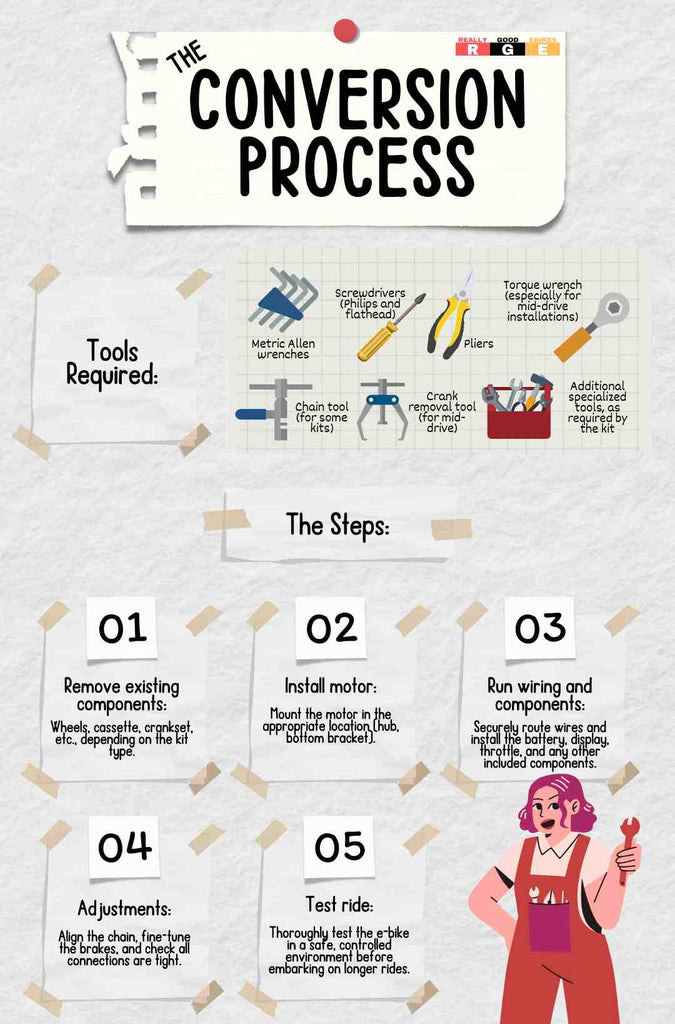
It is important to always refer to the manufacturer's specific instructions for your kit.
Riding Your Converted E-Bike: Safety Considerations
Now that your bike is transformed, it's time for the exciting part – riding! Before hitting the streets or trails, it's crucial to prioritize safety. Always wear a well-fitting helmet, and consider additional protective gear like gloves and knee pads.
Familiarize yourself with the e-bike controls and practice in a low-traffic area to get a feel for how your bike handles with the added power. Start with lower assist levels and gradually increase as you get comfortable.
Importantly, research and understand the legal regulations for e-bikes in your area. Laws can vary significantly between regions and may cover aspects like maximum speed, where you're permitted to ride, and any age or licensing requirements. It's your responsibility to ensure you're operating your e-bike legally. Adhering to regulations not only protects you but ensures that e-bikes remain a welcome addition to roads and trails.
Maintenance and Troubleshooting
Maintaining your e-bike conversion kit is crucial for its longevity and reliable performance. Proper battery care is essential. Follow the manufacturer's recommended charging practices, avoid extreme temperatures, and do not let the battery remain fully discharged for long periods. Ideally, store the battery at a partial charge (around 50-70%) in a cool, dry place.
The motor usually requires little maintenance, but keeping up with regular bike maintenance is important for a smooth e-bike experience. Clean and lubricate your drivetrain regularly, check your brake pads for wear, and ensure all bolts are tightened to the correct specifications. These basic steps help prevent problems that could strain your motor and shorten the lifespan of your system.
Despite good maintenance, issues can still arise. If you notice a reduced range, check your tire pressure, ensure your brakes aren't dragging, and assess your battery's condition. For motor issues, start by checking all connections and wiring for any loose or damaged components.
Here are some basic troubleshooting techniques you can follow:
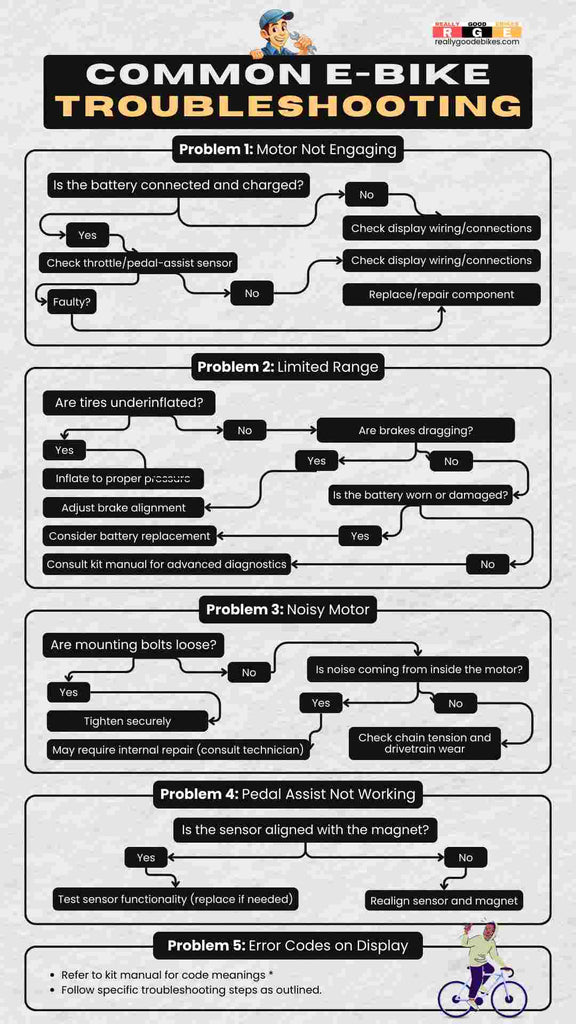
If troubleshooting becomes challenging, consult your kit's instruction manual or online forums, or seek help from a local bike shop. Many e-bike conversion kits include troubleshooting guides, and the online e-bike community can be a great resource for resolving common issues.
Final Thoughts
Choosing to convert your existing bike opens up a world of exciting possibilities. With the right conversion kit, you can rediscover the joy of cycling, tackle new challenges, reduce your environmental impact, and make sustainable transportation a fun part of your life. The key to success lies in finding a kit that aligns with your needs, understanding the installation process or seeking professional help, and always prioritizing safety on the road.
With careful consideration and a dash of adventurous spirit, an e-bike conversion kit can transform your regular bike into so much more. Whether your goal is to conquer hills with newfound ease or simply add a boost of fun to your leisure rides, embracing the possibilities of e-cycling will undoubtedly enrich your life on two wheels.
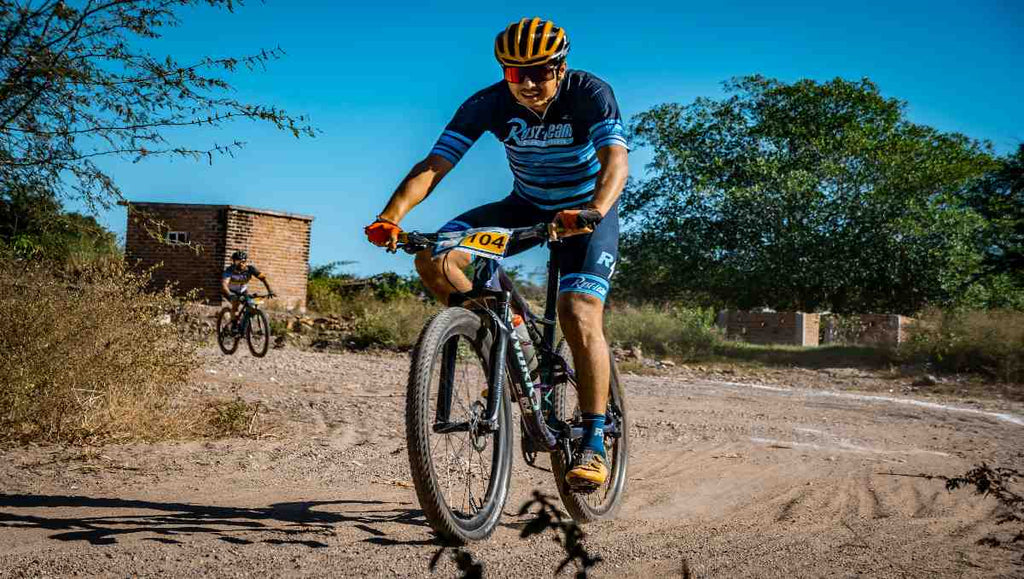
E-Bike Conversion Kit FAQs
Can I convert any bike?
While most standard bicycles can be converted, there are some exceptions. It's best to avoid full-suspension mountain bikes (due to complexity) and bikes with extremely lightweight frames. Always check specific kit compatibility with your bike type, wheel size, and brake system.
Is it worth converting my bike?
This depends on your goals and how much you value your existing bike. Conversions offer a more affordable entry into e-biking than buying a whole new e-bike. If you love your bike but want a boost, it could be a fantastic solution!
How much does a conversion kit cost?
Prices vary depending on kit complexity, motor power, and brand. Expect a range from a few hundred dollars for simple kits to over $1000 for high-end mid-drive systems. Factor in potential installation costs if you're not doing it yourself.
How fast can a converted e-bike go?
Laws dictate the maximum speed of an e-bike. Be sure to research the regulations in your area. Most kits are designed to stay within those legal limits for road use.
Are e-bike conversions safe?
When properly installed and operated responsibly, e-bike conversions can be safe. Always wear a helmet, start with low assist levels, and be mindful of increased speed while getting used to your e-bike.
Leave a comment
Comments will be approved before showing up.
Also in Really Good Ebikes: Electric Bike Blog

Best Electric Bike For Hunting - 2024 Review
May 07, 2024
Discover the best electric bike for hunting in 2024. Our review highlights models that offer quiet operation, rugged performance, and long-range capabilities for successful hunts.
Read More x

